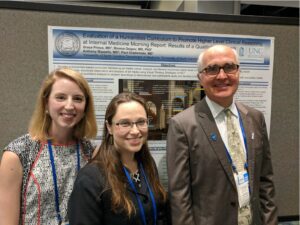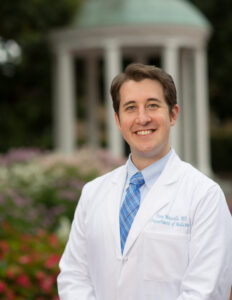
Each morning, Internal Medicine residents take their seats for Morning Report, a case-based resident-led discussion in which Internal Medicine residents share patient case material, develop their diagnostic skills, and solve cases together. But, four or five times a year, instead of analyzing a patient, the residents are presented with classical music, poetry, or Renaissance era paintings for observation and analysis.
Medical humanities, or the practice of infusing the humanities disciplines into medical education, is gaining popularity as a means of improving patient care by teaching future physicians to be more self-aware, better listeners, and more ingrained in the patient experience.
A new medical humanities program at UNC’s School of Medicine is currently in its fourth year, with the goal of helping Internal Medicine residents improve their clinical observation and critical thinking skills.
The program was spearheaded by Grace Prince, MD, an assistant clinical professor in the Division of Endocrinology, Diabetes, and Metabolism at Virginia Commonwealth University and done in coordination with Rimma Osipov, MD, PhD, an assistant professor of medicine in the Division of Hospital Medicine; Anthony Mazzella, MD, a cardiac electrophysiology fellow in the Division of Cardiology; and Paul Chelminski, MD, MPH, FACP, a professor of medicine and the program and division director of the UNC Physician Assistant Program.
“What we did is we took that traditional Morning Report format, but instead of a patient, we had a work of art or a poem or a piece of music,” said Osipov, who is an assistant professor of medicine in the Division of Hospital Medicine. “We treat it the same way where we present the work of art without a lot of details behind it, and then give people time to explore the subject together, as a big group.”
The sessions feature performances by musicians, poets, professors, and art specialists from local art museums and the greater Chapel Hill community. Mina Levin, MD, a retired internist and docent at the North Carolina Museum of Art, and Carolyn Allmendinger, PhD, the director of education and interpretation at the Ackland Art Museum at UNC-Chapel Hill, were instrumental in establishing the program and continue to facilitate sessions on a regular basis.
One of the program’s main objectives is to encourage residents to become more well-rounded physicians, who can briefly step away from the facts and figures and approach their patients with more humanistic tools under their belts. With residency programs becoming more competitive, participants in the program are given the opportunity to improve the “soft” – and often lost – skills such as self-awareness, communication, teamwork, and empathy.
“Residents already have great powers of reasoning,” said Mazzella, who studied music performance prior to medicine. “Applying reasoning to music, art, and literature really strengthens a muscle that we don’t realize we’re using most of the time—the same muscle we use to communicate and interact with patients.”

The program has been in the works for quite some time, especially within the mind of Grace Prince. She has had a unique knack for the humanities ever since her time at Wake Forest University as an undergraduate. As she was studying biology and art history and preparing for a career in medicine, she was often struck by the similarities in which she felt she had to think both in terms of critically evaluating art and critically evaluating her scientific coursework.
As she began her residency at University of North Carolina – Chapel Hill, she found that other institutions around the country have brought medical humanities into different aspects of medical education, but that not a lot had been done linking the medical humanities with clinical reasoning, particularly at the graduate medical education level. So, she decided to get started on her own program as part of a scholarly project during her chief residency.
“I think that, ultimately, people who are drawn to medicine are drawn to science and are puzzle solvers, but we are also uniquely drawn to the underlying human story,” said Prince. “I think that finding a medium that can promote objective components of reasoning and also intertwine that narrative and humanistic component is a great way to enhance or improve the way that we practice medicine.”
In 2019, Prince, Osipov, Mazzella, and Chelminski published their findings from the first year of the medical humanities program in Academic Medicine, the journal of the Association for American Medical Colleges. They revealed a new model in the academic study to show how the humanities may help physicians build better clinical thinking and what impact this type of experiential learning has on physician development and learning.
“We have a model with three parts based on components that have been already tested in medical education settings,” said Chelminski, who is a professor of medicine and an educator of medical students and resident physicians. “We used a very deliberate and intentional approach when creating this program. We did not want to just show pictures and listen to music, but we also wanted to study how people think in these environments when they are exposed to the humanities.”
The model was created using three frameworks from medical educators who have innovated and put medical humanities theories and curricula into practice. The frameworks provided the team with specific ways to measure how a physician’s level of understanding and questioning changed, or became more complex, as they learned more about the patient or artwork.
“Ideally, we would love for this to be something that could be reproduced at other institutions, too,” said Prince. “And so that was really the importance of creating a model of curriculum development. My colleagues and I share the common goal of educating future physicians. I’m sure we’ll have to do more research to get to that point, but that would be the ultimate goal.”
Although the COVID-19 pandemic had temporarily put the program on hold the program and consigned it to a virtual format, it is now in person again. The sessions, which are evolving with the times and the program’s resounding success, are still being held and analyzed by Prince, Osipov, Mazzella, and Chelminski.
Osipov is continuing to build relationships with those working in the humanities on the main campus as well as within the Department of Social Medicine in the School of Medicine to bolster the variety of material that is covered in the program.